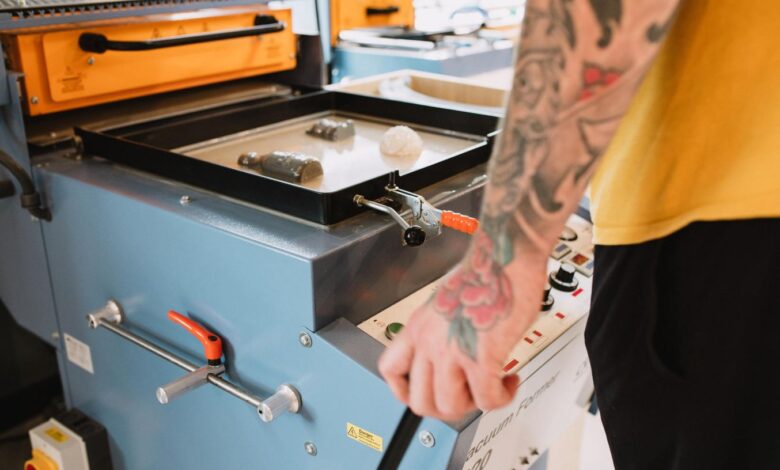The Science Behind Thermoforming: Understanding Material Behavior

Thermoforming is a widely used manufacturing process that involves heating a thermoplastic material until it becomes pliable, then shaping it over a mold and cooling it to create a finished product. From packaging to automotive components, thermoforming finds diverse applications across various industries. However, behind this seemingly simple process lies a complex interplay of material behavior, thermal dynamics, and mechanical principles. In this article, we delve into the science behind thermoforming, focusing on understanding material behavior and its implications for the manufacturing process.
Introduction to Thermoforming
Thermoforming is a versatile manufacturing technique that offers numerous advantages, including cost-effectiveness, rapid prototyping, and the ability to produce complex shapes. The process typically involves the following steps:
- Heating: A thermoplastic sheet is plastic thermoforming solutions heated to a specific temperature, typically above its glass transition temperature, causing it to soften and become malleable.
- Forming: The heated sheet is then stretched or pressed over a mold, conforming to its shape to create the desired part geometry.
- Cooling: Once the part has been formed, it is cooled to solidify the material and maintain its shape.
- Trimming: Any excess material is trimmed away, leaving behind the final part.
Understanding Material Behavior in Thermoforming
The success of the thermoforming process depends largely on understanding the behavior of the thermoplastic material being used. Several key material properties and behaviors come into play:
1. Glass Transition Temperature (Tg):
The glass transition temperature is the temperature at which an amorphous polymer transitions from a hard, glassy state to a soft, rubbery state. Heating the material above its Tg allows it to become pliable and easily deformable, making it suitable for thermoforming.
2. Melting Temperature (Tm):
The melting temperature is the temperature at which a thermoplastic material transitions from a solid to a liquid state. While thermoforming typically occurs below the melting temperature to avoid complete liquefaction, knowledge of Tm is essential for selecting appropriate processing temperatures.
3. Elasticity and Plasticity:
Thermoplastics exhibit both elastic and plastic behavior. During thermoforming, the material undergoes elastic deformation as it is stretched over the mold. Once cooled, it retains its new shape due to plastic deformation, allowing for the creation of permanent parts.
4. Viscoelasticity:
Thermoplastics are viscoelastic materials, meaning they exhibit both viscous (flow) and elastic (recovery) behavior under applied stress. Understanding the viscoelastic properties of the material is crucial for predicting its response during forming and cooling stages.
Implications for Thermoforming Process
Understanding material behavior is essential for optimizing the thermoforming process and ensuring the quality and consistency of the final parts. Several factors must be considered:
1. Heating Rate and Temperature Control:
Controlling the heating rate and temperature distribution across the material is critical for achieving uniform softening and minimizing thermal gradients. thermoforming services Variations in temperature can lead to uneven forming and undesirable part characteristics.
2. Forming Pressure and Time:
Applying the appropriate forming pressure and allowing sufficient time for the material to conform to the mold are crucial for achieving accurate part geometry and surface finish. Too much pressure can cause thinning or stretching, while too little pressure may result in incomplete forming.
3. Cooling Rate and Uniformity:
Proper cooling is essential for solidifying the part and maintaining its shape. Controlling the cooling rate and ensuring uniform cooling across the part surface help prevent warping, shrinkage, and other dimensional variations.
4. Material Selection and Testing:
Choosing the right thermoplastic material for the application requires consideration of its properties, including Tg, Tm, elasticity, and viscoelastic behavior. Conducting material testing and validation ensures compatibility with the thermoforming process and desired part specifications.
Conclusion
Thermoforming is a complex manufacturing process that relies on a deep understanding of material behavior and processing parameters. By comprehending the science behind thermoforming, manufacturers can optimize the process, improve part quality, and explore new applications for thermoplastic materials. As technology advances and materials evolve, continued research into material behavior will drive innovation and unlock new possibilities in thermoforming applications.
FAQs
- What are some common thermoplastic materials used in thermoforming?
- Common materials include polyethylene (PE), polypropylene (PP), polystyrene (PS), and polyvinyl chloride (PVC), among others.
- How does thermoforming compare to other manufacturing processes like injection molding?
- Thermoforming offers advantages such as lower tooling costs, shorter lead times, and greater design flexibility compared to injection molding, especially for large, low-volume parts.
- What are some challenges associated with thermoforming?
- Challenges include material uniformity, maintaining part thickness consistency, and minimizing defects such as air traps and surface imperfections.
- Can thermoformed parts be recycled?
- Yes, many thermoformed parts are recyclable, contributing to sustainability efforts in manufacturing and packaging industries.
- What are some emerging trends in thermoforming technology?
- Emerging trends include the use of advanced materials, automation and robotics, and digital simulation tools for process optimization and quality control.
I hope you found this article informative and insightful! If you have any further questions about thermoforming or material behavior, feel free to reach out.





